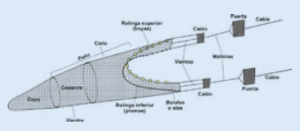
More than 40 years as a net-maker
Eliseo Vicente Albiol, "Lise" (1965)
Avi Tonet´s Apprentice.
Eliseo Vicente Albiol, “Lise” (1965), a native of Barceloneta, grandson of Avi Tonet who taught him to mend the nets of the family boat, the Maireta II, when he was 16 years old. This is how he earned “the first pesetas for my expenses” while learning the secrets of the trade from the best master. Then came the nets of the Virgen del Amparo II of the Caparrós family. In 1990, Avi Tonet died and Lise, already an experienced net-maker, took over the work with the help of Tomás, also from the family.
The work of a net-maker is an art.
 From mending a broken net that requires cutting and replacing the affected piece, to putting them together and even designing them from scratch. “We are like a tailor who can repair the fibres of a suit with a magnifying glass if it tears”, compares Eliseo, and like a dressmaker or pattern maker, who designs the gear to suit each boat, conditioned by its power, the type of fishing or even the preferences of each skipper.
From mending a broken net that requires cutting and replacing the affected piece, to putting them together and even designing them from scratch. “We are like a tailor who can repair the fibres of a suit with a magnifying glass if it tears”, compares Eliseo, and like a dressmaker or pattern maker, who designs the gear to suit each boat, conditioned by its power, the type of fishing or even the preferences of each skipper.
The work of the net-maker, also sometimes called “armador”, is a totally artisanal job. It takes two people about three weeks to make a net approximately 90 metres long, using a needle and a knife as the only tools for weaving with synthetic thread (nylon, polyester and polypropylene) or the nail to fix or make the ropes
A trawler fishing net-maker, like Lise, is not light fishing net-maker and vice versa. Each modality requires a specialisation. The trawlerman is considered to be the land seaman of the boat, paid “a la parte” (a variable distribution conditional on the sale at auction) like the rest of the crew. Each boat usually has 5 to 10 gears, which must be kept in optimum condition.
Times are changing.
Many years have passed since those images of women wearing hats to protect themselves from the sun mending nets in the Platgeta. “Traditionally, the women mended and sewed the nets and it was the men who put them together. Likewise, the women used scissors and the men knives to perform the same function”. A curious custom that Eliseo points out to us.
But the profession is “in danger of extinction. Without going any further, in the 80s and 90s the fleet was made up of more than 40 trawlers alone, and seven or eight rowers worked for them. Today there are two of us”. Those were different times in the Moll del Rellotge and in most fishing guilds. The figure of the apprentice has not existed for a long time and we find ourselves in a very difficult sector.

“We used to be like a big family. On Saturdays, the fishermen would take the opportunity to do their chores on land (cleaning the engine, painting, etc.) and we would purposely leave our work as an excuse to go down to the quay, as we knew that the morning would end in a bar in the neighbourhood with lunch and hours of conversation and fun”. Lise recalls with a certain nostalgia.
“WE ARE LIKE A TAILOR WHO CAN REPAIR THE FIBRES OF A SUIT WITH A MAGNIFYING GLASS IF IT TEARS”

Pattern with technical specifications for the manufacture of a craft. Indicating: Length of each part of the gear, mesh dimensions and thickness, number of passes, materials, type of braid and cut.

Parts of the net
The trawl net is a funnel-shaped net that trawls the seabed towed by a vessel. The two wings of the trawl are attached to the boat by two metal cables; each wing is usually fitted with a metal “door” that holds the mouth of the trawl open. The upper part of the mouth of the net is fitted with floats, while the lower part is weighted so that it slides close to the bottom. The mesh sizes of each part of the net are adjustable.
-Uve or uves: the parts that separate the cork from the lead.
-Relines: cork is the upper braid of the gear and lead is the lower luff. In the past, lead and corks were put on them to make them settle and float. Now plastic floats and chains are used.
-Band: a net that goes from the end of the barb to the mouth of the cork.
The top of the net that goes from the mouth of the cork to the perpendicular of the mouth of the lead. This is the part of the gear where there is only netting at the top so that the fish do not flee upwards, as the mouth of the cork and the mouth of the lead are not on the same perpendicular. The cork is always more advanced. The cork is always further forward.
-Crown or codend: this is the final part, where the caught fish is piled up. It is always made of stronger thread. Its thickness is specially controlled by the Authorities.
